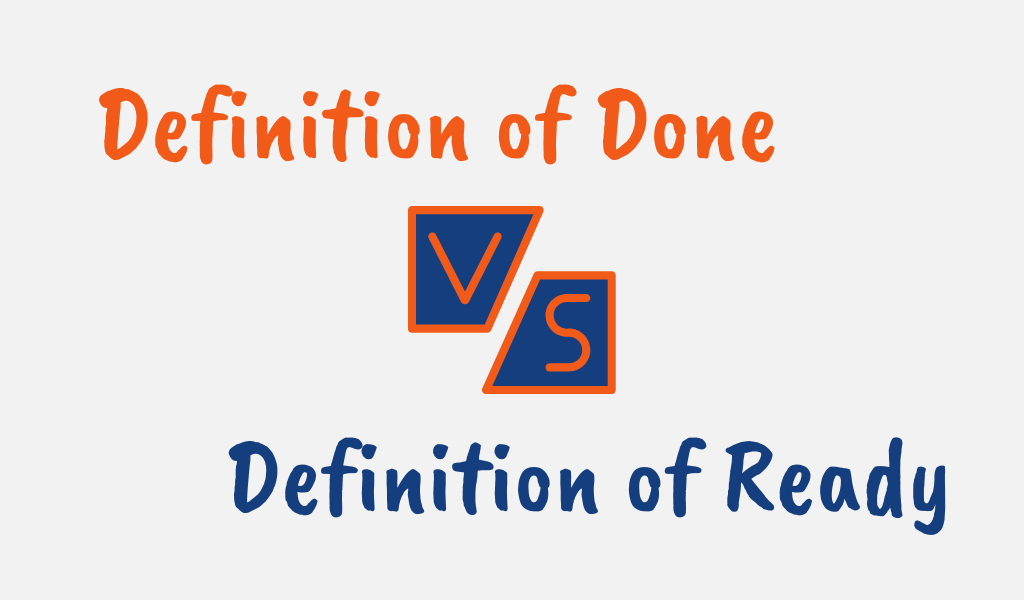The Definition of Done (DoD) and Definition of Ready (DoR) are two critical checklists that enable Scrum and Agile software development teams to deliver high-quality, valuable Product Increments consistently.
While related, they both serve slightly different purposes in Agile development. In this article, we’ll compare Definition of Done vs Definition of Ready to understand their differences, and provide examples of each.
We’ll also cover how they collaborate to ensure requirements are clear and quality is built into Agile projects.
Difference Between Definition of Done and Definition of Ready
The main difference is that the Definition of Ready (DoR) specifies the criteria a user story or Product Backlog item must meet before the development team can start work on it during the Sprint.
And the Definition of Done (DoD) on the other hand sets the standards that completed work must achieve in order to be considered complete and thus releasable.
What is Definition of Done in Scrum and Agile?
The Definition of Done (DoD) in Agile and Scrum methodologies is a clear and concise list of requirements that a software Product Increment must meet to be considered complete and releasable.
The DoD ensures transparency in product development and drives quality as it provides a checklist that must be fully covered for a Product Increment to be potentially shippable.
It also helps to set expectations, create consistency, and eliminate ambiguity in the completion of work, making it a critical aspect of Agile development.
While the DoD can vary from one team to another or from one project to another, based on the project scope, the team’s working agreement, or the organization’s standard, it should be agreed upon at the start of the project and be reviewed and updated as necessary throughout its life.

What is Definition of Ready in Scrum and Agile?
The Definition of Ready (DoR) in Scrum and Agile is a set of criteria that a user story must meet before it can be accepted into the Sprint Backlog.
It ensures clarity and completeness of the story, reducing ambiguity and misinterpretation.
The criteria may include clear acceptance criteria, size appropriateness for a Sprint, and the story being value-driven and testable.
Using this criteria helps teams avoid ineffective Sprints by ensuring they only work on well-understood and feasible tasks.
The INVEST criteria model provides a firm foundation for the DoR, and you can read more on that here.

Definition of Done vs Definition of Ready: Feature Comparison
At first glance, the Definition of Done (DoD) and Definition of Ready (DoR) seem quite similar as they’re both checklists that define criteria for work items in Agile development.
However, when examined more closely, there are several key differences between these two definitions as earlier iterated.
Here is a head-to-head comparison to further highlight their differences:
1. Purpose
The DoD defines the minimum quality standards and requirements for increments of work to be considered releasable and complete. Its purpose is to prevent inadequate work from being pushed downstream.
In contrast, the DoR defines the entrance criteria for new pieces of work to be brought into a Sprint to prevent work that is unclear or not fully prepared from being pulled into the current iteration.
2. Focus
While the DoD focuses on the outputs of development, the quality of work completed, and the finished product, the DoR’s focus is on the raw material, and preparation and readiness of incoming work for development.
3. Ownership
The DoD is created collaboratively by the development team, while the DoR is the primary responsibility of the Product Owner.
4. Timing
The DoD is used after the work item has been developed and is ready for review. It helps the team know when a task is truly complete.
In contrast, the DoR is established before a work item enters the development phase and helps the team confirm that the item meets the criteria required for development work to start.
5. Impact
When properly applied, the DoD prevents inadequate work from being released while the DoR prevents work that is not ready from queueing up. The DoD is backward-facing while the DoR is forward-facing.
6. Criteria
For the DoD, the criteria often include things such as code is written, code is reviewed and accepted, unit tests are written and passed, documentation is updated, etc.
For the DoR, the criteria used typically involve things like a clear description of the work, acceptance criteria, any dependencies identified, and any necessary mockups or design work completed.
7. Role in Scrum Ceremonies
According to the Scrum Guide, every Scrum artifact has a commitment to ensure it provides information that enhances transparency and focus against which progress can be measured.
The DoD is the commitment for the Product Increment and is used during the Sprint Review and Retrospective to verify if the work items have been completed to the team’s satisfaction and to improve the team’s definition for future Sprints.
The DoR on the other hand is not mentioned in the Scrum Guide but is often discussed during the Backlog Refinement or Grooming where the Product Owner and the development team review and discuss the upcoming work items.
8. Impact on Velocity
Velocity is a metric used in Scrum to measure the work done by a team in a Sprint. If backlog items are not “Done,” they cannot be counted in the Sprint’s velocity, which can lead to overestimation of the team’s capacity in future Sprints.
On the other hand, if items are not “Ready,” it may lead to delays in the start of work, interruptions, or blockages during the Sprint, which can reduce the team’s velocity.

What is the Importance of Definition of Done?
A clear Definition of Done is an essential Agile and DevOps practice that enables teams to align on done-ness, meet quality bars, estimate accurately, ship value regularly, and improve continuously.
Some of the key importance of having a Definition of Done (DoD) include:
- Sets Clear Expectations: A DoD establishes shared standards across the team for when a work item is complete. This avoids confusion on expected quality or scope.
- Enforces Quality: A DoD acts as a checklist to ensure quality standards are met before signing off. This prevents half-done work from slipping through.
- Enables Estimation: Teams can more accurately estimate work when they know the exact criteria for completion and a DoD provides this consistency.
- Shippable Increments: Having a DoD means that each completed item is potentially a shippable code which enables regular delivery and feedback.
- Continuous Improvement: The team can review and update the DoD over time as processes improve and it becomes a living document for increasing maturity.
What is the Importance of Definition of Ready?
An effective Definition of Ready aligns the team on requirements, constraints, dependencies, and risks before pulling work into a sprint. This results in smooth execution with fewer impediments and disruptions.
The key importance of the DoR include:
- Clarifies Requirements: The DoR forces discussion to ensure the requirements and acceptance criteria are clear before work begins to avoid misalignments.
- Confirms Feasibility: The DoR may require technical spikes or design reviews to confirm the work can be successfully implemented within time/skill constraints.
- Enables Estimation: With clear requirements and known feasibility, the team can more accurately estimate the level of effort needed.
- Prevents Bottlenecks: By ensuring dependencies are addressed and nothing is blocking the work item, the DoR prevents unintended bottlenecks.
- Improves Focus: With a DoR, the team knows precisely what to work on and can stay focused ensuring there is no ambiguity on scope or expectations.

Definition of Done Examples
Examples of DoD criteria include:
- All code is peer-reviewed and approved by the team.
- Automated unit and integration tests have been written and passed.
- Manual testing has been completed and all critical bugs are fixed.
- New code has been merged into the main branch.
- Code adheres to the style guide and passes all linting/static analysis.
- Documentation has been updated for any changes to APIs or architecture.
- The build passes all tests and packaging steps.
- The product owner has accepted the user story as complete.
- Monitoring, logging, and alarms are set up for new features.
- The deployment process runs successfully and the feature can be verified in production.

Definition of Ready Examples
Here are some examples of Definition of Ready criteria:
- The user story is clear, concise, and testable, and its acceptance criteria are defined.
- Dependencies on other stories/issues are identified and those stories are completed first.
- The team has enough capacity to work on the story in the current Sprint.
- The story is estimated and point values or time estimates are agreed upon.
- The acceptance criteria and validation steps are defined.
- Any technical spikes needed to assess feasibility are done.
- The required design discussions have occurred.
- The team has access to the resources, tools, and documentation needed to complete the work.
- The story is approved by the product owner and prioritized on the Product Backlog.
- There is a shared understanding among the team on the scope and implementation details of the story.
How Definition of Done and Definition of Ready Play Complementary Roles in Agile
Irrespective of these differences, the Definition of Done (DoD) and the Definition of Ready (DoR) work together to enable Agile teams to deliver high-quality increments.
The DoR is vital in ensuring that each user story meets the necessary entrance criteria to be successfully completed in a Sprint. By only bringing in ‘ready’ stories, the team sets itself up for success.
The DoD then provides the quality standards each increment must achieve to be releasable. Well-defined ‘ready’ work is more likely to become ‘done’.
The DoR gates what comes into a Sprint, and the DoD what goes out, together enabling a smooth flow of value delivery.
Conclusion
In a nutshell, the Definition of Ready and the Definition of Done provide two critical guideposts for Agile teams to enable smooth flow, high performance, and consistent value delivery.
While the DoR filters what work can be brought into a Sprint, keeping the team’s intake aligned with their capacity to deliver, the DoD filters what work can be pushed out, maintaining high-quality standards for releasable increments.
In tandem, these two definitions foster transparency, alignment, and accountability. It is essential to keep them clear, concise, actively used, and revisited regularly as a team to ensure they continue to set your project up for Agile success.
FAQs
Who Defines Definition of Done?
The Definition of Done (DoD) is collaboratively defined and agreed upon by the entire Agile team, including developers, testers, Product Owner, and Scrum Master.
Who Defines Definition of Ready?
The Definition of Ready (DoR) is typically defined collaboratively by the Product Owner and the development team in an Agile or Scrum environment, ensuring all requirements are understood before starting work.





